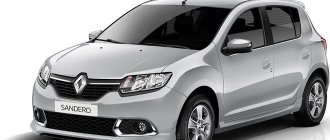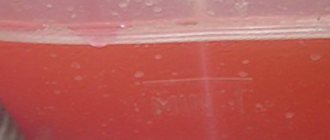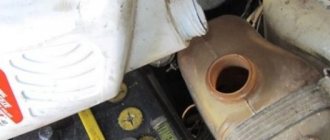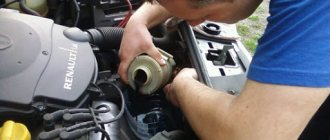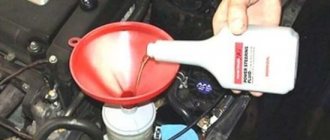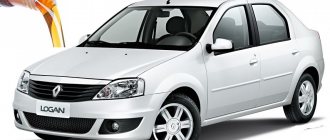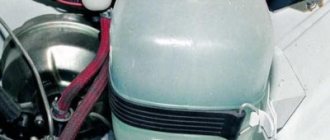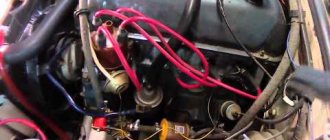A car, as everyone knows, consumes not only gasoline, but also contains additional filling fluids. But often car owners go to a service center because they don’t know how and how much to fill antifreeze, hydraulics, motor oil into the engine, etc. And that’s why go to a service center and pay your own money when you can do it all yourself . If you are the owner of Renault Logan, then you are very lucky that you have come to this page, because we will talk about this particular car.
Regulations for Renault Logan
According to the regulations from the official dealer, antifreeze under the ELF GLACEOL RX Type D Renault brand is recommended for replacement as a coolant.
Factory antifreeze catalog number
The chemical composition of such a product includes distilled water, ethylene glycol (96% of the total composition) and 4% of various additives, which provide all components with anti-corrosion resistance from external factors. Such corrosion inhibitors are suitable for use in all cooling systems for both copper and aluminum radiators.
The recommended antifreeze is completely safe for plastics, paint, varnish, as well as rubber pipes and seals.
What does branded antifreeze look like?
Renault Glaceol RX Type D concentrate
Branded antifreeze for Renault Logan is yellow in color and is supplied as a concentrate in 1 liter bottles.
It should be diluted in a clean container in a 1:1 ratio with distilled water. A diluted composition in this ratio performs well at temperatures as low as -40°C.
However, if the ambient temperature does not drop to such levels, the percentage of concentrate in the water can be adjusted independently in other proportions.
Under the hood of the two-liter Renault Logan in the new body there is also yellow antifreeze (photo of the editorial car)
Manual
According to the operating manual for the Renault Logan car, the antifreeze should be completely replaced every 90,000 kilometers.
However, you shouldn’t specifically wait for this mileage; you need to monitor the color of the coolant, and when it acquires a dirty shade with an unpleasant odor, it means it’s time to make a replacement, thereby pouring the product only into a clean environment, having previously cleaned the system of old fluid.
Such recommendations are given to ensure that the composition of the used product does not interfere with the effective operation of the newly filled antifreeze. To completely replace the system, you will need from 6 to 8 liters (depending on engine size) of antifreeze diluted to the required concentration.
Precautionary measures
First, you should pay attention! If you are doing such work on your car, you should follow standard safety standards: before starting work on replacing antifreeze, wait a certain time. Before the replacement itself begins, you should wait for the general cooling of the engine in the Logan car and wait until the liquid in its cooling system cools down
Before the replacement itself begins, you should wait for the engine in the Logan car to cool down generally and wait until the liquid in its cooling system cools down.
Since during its operation, the engine temperature increases to more than 100 degrees. When working with the coolant mixture, try to use special protective gloves, since their durable base and chemical composition will protect you from antifreeze.
Choice of antifreeze
Nowadays Renault Logan coolant is presented in huge quantities on the market, so it has become very difficult to make a choice. The article will give some recommendations for selection, and also discuss several popular types of liquids.
- Carboxylate antifreeze. Due to the fact that it has balanced conditions of excellent quality, it can be used at different temperatures. This category of coolant has basic formulas that ensure reliable protection of its properties. This type eliminates the possibility of any unexpected malfunctions occurring during vehicle operation. Therefore, many manufacturers prefer this antifreeze for their cars.
- In the nineties, the hybrid type was in great demand, but today it is also popular among many car owners. This popularity is due to its reliability and long-term preservation of its positive properties.
- The traditional type of coolant is considered outdated, although it has excellent conditioning properties that last for quite a long time
- The most modern and promising development today is the Lobrid type. Due to the fact that the composition includes all kinds of additives and additives that increase the protective properties of the heads and cylinder block, this type occupies a leading position among the favorites in this segment.
Therefore, the Renault Logan cooling system will work perfectly with this type of coolant. But despite this, everyone can choose exactly the one they see fit.
Many believe that the quality of the liquid depends on the color, and also that they can be compatible with each other depending on the color scheme. But this does not mean that pouring, for example, yellow coolant into the system will somehow behave worse, so the best option would be to consult with the official manufacturer on this issue.
Product classification
Before purchasing any product, we recommend that you familiarize yourself with the existing types and their features.
This is important if you select analogues for original products. Most often, manufacturers and drivers use the classification from the Volkswagen concern.
It includes the following classes of coolants:
- G11 is a classic ethylene glycol-based product. Contains numerous additives, including for corrosion protection. Their use slightly impairs heat transfer, which results in a short service life - the maximum limit is only 2 years. Typically blue or green in color.
- G12 (+,++) – compositions based on organic acids with carboxyl additives. The key feature is that the additives begin to envelop only vulnerable areas with a protective film, and not the entire surface. The advantages include improved heat transfer, absence of abrasive and a service life of 3-5 years. Usually painted red.
- G13. The main feature is the propylene glycol base, which, unlike ethylene glycol, is environmentally friendly. Available in red and yellow. This is where the differences end. The characteristics are identical to the G12 variations.
Which of these is better is a controversial question. Here you should first of all focus on the material that is used in the cooling system. If the radiator is made of copper or brass, then it is preferable to use carboxyl compounds (G12) or coolant without silicates (G13). For structures made of aluminum and its alloys, a silicate composition (G11) is suitable.
Another question: which is better - antifreeze or antifreeze. Antifreeze is a foreign designation for basically all coolants. Antifreeze, in turn, is already the name of a specific product developed back in Soviet times.
In fact, according to its characteristics, antifreeze can be classified as one of the subgroups of antifreeze. You shouldn’t get hung up on the names, because when choosing, you need to take into account the manufacturer’s recommendations and composition parameters.
How to replace antifreeze on Renault Logan?
Replacing antifreeze on a Renault Logan includes draining the fluid, flushing the system if necessary, and adding new antifreeze. Knowing the precautions and what tools should be prepared will help you replace antifreeze on Renault Logan, in particular, as well as on Renault Sandero and Renault Koleos, without difficulty.
A complete replacement of antifreeze on Renault Logan is possible using the following tools and consumables:
- To protect the skin, gloves and thick rags made from natural fabrics are used;
- Tools: ten key for removing crankcase protection;
- screwdriver;
- hose clamps;
- pliers.
- 6 liters of water, which are mixed with ELF GLACEOL RX Type D Renault 7711428132 antifreeze in a ratio of 1/1;
So, how much coolant is needed to replace antifreeze in Renault Sandero and Logan, and which one should you choose? Until 2009, Renault recommended TOTAL GLACELFAUTOSUPRA. Now, this product is practically not found on sale, so a product such as ELF GLACEOL RX TypeD is relevant.
We recommend: Which summer tires are best for Renault Logan: let’s look at the essence
The liquid described above is a concentrate, which is diluted with distilled water in a ratio of 1/1. Owners of Renault Logan with 1.4 and 1.6 engines purchase 5.5 liters of antifreeze. Three 1-liter canisters are diluted halfway with water. The remaining half liter of the finished liquid is used if necessary to add the product to the tank.
Precautionary measures
Please note that compliance with safety measures when performing such actions is mandatory.
- It is necessary to allow the engine to cool, as well as the fluid in the cooling system. In operating condition, the temperature rises to 90 degrees, which is incompatible with performing the required actions;
- Antifreeze contains chemical elements that can cause harm if it comes into contact with the skin;
- It is important to depressurize the cooling system itself to perform subsequent maneuvers. This is achieved by unscrewing the cap of the expansion tank;
- It seems reasonable to prepare a container in advance where the product will be drained. Since its composition is chemical, it can damage the area of the earth where it spills.
Draining the coolant and flushing the system
How to replace antifreeze in Renault Logan yourself? You should start by draining the unusable liquid. First, excess pressure in the Renault Logan cooling system is released. The expansion tank cap is opened, after which a number of actions are performed:
- The engine protection, which is attached with 6 bolts, is removed. To do this, they need to be unscrewed;
- A container is installed under the engine into which used antifreeze will be drained. In practice, it is convenient to use a cut canister;
- The expansion tank cap should be closed at the initial stage, which will reduce the intensity of the drain;
- Using a slotted screwdriver, disconnect the hose clamp on the lower radiator pipe;
- After removing the sleeve, the coolant is drained into a fixed container;
- To increase the pressure, it is necessary to remove the plug from the expansion tank, then unscrew the fitting, thus releasing air from the system;
- After the coolant has been completely drained, attach the hose to the radiator pipe. It must be secured with a new worm clamp.
A number of motorists ask the question: is it necessary to flush the cooling system when replacing antifreeze in a Renault Logan? To answer this question, it is necessary to establish 2 important points:
- what is the service life of the car?
- How long has the antifreeze been in use, or when was it last changed?
Having received answers to these questions, you can decide whether the system needs to be flushed.
In any case, flushing your car's cooling system is never unnecessary. To do this, insert a water supply hose into the filler neck, after which running water is turned on. By the color of the liquid coming out, you can understand how thoroughly the system requires cleaning.
If the radiator is not operating satisfactorily, it must be flushed. You can do this yourself, or seek the help of a specialist. But what to do in case of complex pollution? To do this, special cleaning agents are used, which are diluted in water and the system is washed. The car must be used for up to 2 days, after which fresh antifreeze is added.
Filling with new antifreeze
The scheme for filling the cooling system with antifreeze is as follows:
- Coolant is poured through the neck of the expansion tank. This is done until the antifreeze fills the required volume and flows out of the air bleeder hole;
- The expansion tank cap is screwed on, as well as the fitting cap;
- The driver starts the engine and waits for the cooling system fan to turn on. After this, it is necessary to stop the internal combustion engine;
- Allow the engine to cool;
- Release the air using the fitting;
- Check the level of filled antifreeze. If it does not reach the required level, top up;
- Reinstall the engine crankcase protection;
- Having followed the above recommendations, the process of replacing antifreeze in Renault Sandero, like Renault Logan, is completed.
Leaks and problems
There can be many reasons why antifreeze leaves, so in each specific case you need to immediately look for the cause, and then think about how to eliminate it. For example, if the interior smells of antifreeze, then there is a high probability that there is a problem with the stove or its pipes.
In general, when changing the coolant, you should carefully inspect all hoses and pipes for cracking, so that if something happens, replace them immediately. It is also worth paying attention to the thermostat, because most problems with poor heating lie there.
Users also note problems with the expansion tank. The plastic inside, which becomes brittle over time, breaks off and gets into the cooling system. Most often, the stove becomes clogged with these debris. Therefore, if a problem is detected, it is recommended to replace the tank immediately.
Removing old fluid
Do not attempt to pull off the lower radiator hose without first loosening the tension clamp. When removing the locknut, you need to inspect the clamp. If it is original, it will have to be replaced. The French automaker supplies disposable clamps.
Next you need to proceed in the following order:
- The hoses are removed from the radiator and the expansion tank pipe. This will allow you to quickly drain the Renault Logan antifreeze and ensure a high-quality replacement in the future.
- Due to the design of the car, simply disconnecting the hoses will not completely get rid of antifreeze. Some of it will remain in the radiator. To completely remove antifreeze, you need to remove the tubes from the thermostat hoses and lower their container with the drained liquid.
- The cooling system is purged using a compressor. Air must be supplied simultaneously - through the expansion tank and thermostat hoses. The pressure should not be excessive to prevent damage to the radiator honeycomb.
- After the cooling system is completely empty, you can return all hoses and clamps to their place.
After the procedures have been completed, you can begin to fill in new fluid. The choice of antifreeze is up to the car owner. There was a time when Renault engineers recommended using antifreeze called GLACELF AUTO SUPRA produced by Total. It is easily recognized by its orange color. But today the automaker recommends using Renault Glaceol RX Type D. Antifreeze of this brand is available in the form of a concentrate, and before filling it must be diluted with distilled water.
Products from both brands can be safely used. It is of high quality and is suitable for the Renault Logan cooling system with 1.4 and 1.6 engines.
Scope of application
Ready-to-use Renault coolant
The original antifreeze from Renault was developed for use in the cooling systems of any modern internal combustion engines. It is best suited for Renault-Nissan engines.
It is completely neutral to metal alloys and rubber compounds, which allows it to be used in cooling systems with copper and rubber parts.
Important! In the event of an antifreeze leak, the manufacturer strongly does not recommend mixing it with other brands of antifreeze, even if they have a similar green color. The best solution would be to add the same antifreeze to the cooling system. If you don’t have the same canister of Antifreeze concentrate Renault Type D with you, you can mix it with ordinary distilled water until the leak is eliminated and all the coolant is replaced.
What antifreeze to use for Renault Logan
First, you should clearly understand the following rule: you should only pour coolant into a clean system. This will allow the new antifreeze not to lose all its qualities when mixed with a used product.
The recommendations of the official Renault Logan dealer come down to a type “D” product, ELF brand, called “GLACEOL RX Type D 1L Renault 7711428132”, manufactured by Total. In stores, this product is offered in the form of a concentrated solution in one-liter containers.
Its chemical composition contains the substance ethylene glycol, distilled water and additives consisting of components such as an aqueous solution, glycerin and alcohol. Ethylene glycol and water are the basis of the liquid, which makes up 96 percent of the total volume, the rest is additives. They help combat corrosion in a wide range of radiator cooling systems, namely those made from cast iron, copper and aluminum.
Before using the concentrate, it must be diluted with distilled water in a ratio of 50X50. And as a container for dilution, you can use plastic bottles of one and a half or two liters. The resistance to winter temperatures of the finished antifreeze inspires confidence; it does not freeze at -35.40 degrees below zero. By changing the dilution ratio, for example to 30x70, you can operate the car in different climatic zones.
Antifreeze from the manufacturer Total is safe for plastic and rubber products, as well as for containers painted with paint or varnish. In order to completely fill Renault Logan with new coolant, it is necessary to prepare 608 liters of working product the day before, its quantity depends on the appetite of the engine. You can get this amount of antifreeze by purchasing at least 3-4 liters of concentrate. The remainder will be used for refilling during use of the car, so you should always have it in the trunk.
Antifreeze type GLACEOL RX Type D costs from 330 to 350 rubles per liter, but it is advisable to purchase from trusted sellers or official dealers so as not to “run into” a fake. Distilled water is also sold in specialized auto stores and can be purchased without any problems.
Let's summarize
Many car owners skip the flushing step - it is not cost-effective. Old antifreeze, corrosion particles, sediment and other impurities remain in the system. They quickly mix with the new composition, it loses its protective properties. Flushing lengthens the procedure, but also extends the life of the coolant. On the first day of operating the machine, you need to monitor the fluid level. If it decreases, there is air left in the system.
Sources
- https://razborov.net/renault/reno-logan-kak-slit-antifriz.html
- https://SpecTorg.su/tehobsluzhivanie/zamena-antifreeza-reno-logan.html
- https://ZamenaKolesa.ru/pro-dvigatel/zamena-antifriza-reno-sandero-2.html
- https://asx-club.su/doityourself/kak-zamenit-antifriz-na-reno-logan-samomu.html
- https://ZamenaRenault.ru/logan/dvigatel-logan/ohlazhdayushhaya-zhidkost-antifriz-2.html
- https://carenault.ru/logan/obsluzhivanie-sistemy-ohlazhdeniya-reno-logan-zamena-zhidkosti-termostata-i-datchika/
- https://NewLogan.ru/kak-zamenit-antifriz-na-reno-logan.html
- https://sto-tolyatti.ru/dvigatel/sistema-ohlazhdeniya-reno.html
- https://rulikoleso.ru/to-renault/zamena-antifreeza-renault-logan
- https://autorn.ru/renault/482-zamena-antifriza-renault-logan-svoimi-rukami.html
Regulations for Renault Logan
According to the regulations from the official dealer, antifreeze under the ELF GLACEOL RX Type D Renault brand is recommended for replacement as a coolant.
Factory antifreeze catalog number
The chemical composition of such a product includes distilled water, ethylene glycol (96% of the total composition) and 4% of various additives, which provide all components with anti-corrosion resistance from external factors. Such corrosion inhibitors are suitable for use in all cooling systems for both copper and aluminum radiators.
What does branded antifreeze look like?
Renault Glaceol RX Type D concentrate
Branded antifreeze for Renault Logan is yellow in color and is supplied as a concentrate in 1 liter bottles.
It should be diluted in a clean container in a 1:1 ratio with distilled water. A diluted composition in this ratio performs well at temperatures as low as -40°C.
However, if the ambient temperature does not drop to such levels, the percentage of concentrate in the water can be adjusted independently in other proportions.
Under the hood of the two-liter Renault Logan in the new body there is also yellow antifreeze (photo of the editorial car)
Manual
According to the operating manual for the Renault Logan car, the antifreeze should be completely replaced every 90,000 kilometers.
However, you shouldn’t specifically wait for this mileage; you need to monitor the color of the coolant, and when it acquires a dirty shade with an unpleasant odor, it means it’s time to make a replacement, thereby pouring the product only into a clean environment, having previously cleaned the system of old fluid.
Such recommendations are given to ensure that the composition of the used product does not interfere with the effective operation of the newly filled antifreeze. To completely replace the system, you will need from 6 to 8 liters (depending on engine size) of antifreeze diluted to the required concentration. If you have any difficulties with your car, we recommend that you make a diagnostic card online to avoid problems in the future.
Beware of fakes!
Counterfeiting coolants is one of the most profitable sectors for fraudsters. These compositions are easy to dilute, and buyers won’t even guess. If you don't want to end up with low-quality products, follow these purchasing criteria:
- Price. The market price of products in most stores is the same. Counterfeits usually sell for less.
- Sealing of the eggplant. It is enough to turn it over or squeeze it. If a leak appears or air begins to bleed, then it is a fake.
- Tara. Counterfeits often have a different tone or are even bottled in bottles that do not match the original shape of branded products.
- Foam. In the new product, when shaken, the foam should shrink within 3-5 seconds.
- The quality of the label. Uneven or blurry font, lack of a spill date, cloudy colors or poor adhesive quality - all this will help identify the product of a “widespread” spill.
Remember that it is best to buy coolant in branded stores or trusted points of sale.
Renault Logan fuel and lubricant refueling tanks
| Filling/lubrication point | Refill volume | Name of oil/liquid |
| Fuel tank for all engines | 50 liters | Unleaded gasoline with an octane rating of at least 92 |
| Engine lubrication system (including oil filter) engines: | ||
| 1.4 l. 8 valves | 3.3 liters | ELF EVOLUTION SXR 5W30 |
| 1.6 l. 8 valves | ||
| 1.6 l. 16 valves | 4.9 liters | ELF EVOLUTION SXR 5W40 |
| Engine cooling system: | ||
| For all engines | 5.45 liters | GLACEOL RX Type D |
| Transmission | ||
| Manual transmission | 3.1 liters | ELF Tranself NFJ 75W80 or Elf Tranself TRJ 75W-80 |
| Automatic transmission | 7.6 liters | Elf Renaultmatic D3 SYN Elfmatic G3 |
| Power steering | 1 liter | Elf Renaultmatic D3 SYN Elfmatic G3 |
| Brake system | 0.7 liters (with 1 liter pumping) | ELF 650 DOT 4 |
What and how much to fill in Renault Logan
Engine lubrication system.
Logan is equipped with only three engines: 1.4 liters. 8 valves; 1.6 l. 8 valves; 1.6 l. 16 valves.
If we take the first two engines (1.4 l. 8 valves; 1.6 l. 8 valves), then their volume does not change (3.3 l.) and neither does the oil (ELF EVOLUTION SXR 5W30). But in the case of 1.6 liters. 16 valves, then the oil (ELFEVOLUTION SXR 5W40) and volume (4.9 liters) change.
Engine cooling system.
Here you already need to pour the same antifreeze into all engines: GLACEOL RX Type D, and the volume also does not change - 5.45 liters. Before using antifreeze, it must be diluted with distilled water, the proportion is one to one. In this case, your liquid will solidify only at a temperature of -36 degrees.
Fuel.
The tank has a volume of 50 liters, you need to pour gasoline of at least 92 octane.
Transmission
For manual transmissions, ELF Tranself NFJ 75W80 or Elf Tranself TRJ 75W-80 oil is used, and the fill volume is 3.1 liters.
For the automatic transmission, Elf Renaultmatic D3 SYN Elfmatic G3 oil is used, and 7.6 liters will need to be filled.
The hydraulic booster uses Elf Renaultmatic D3 SYN Elfmatic G3 fluid and needs to be filled with 1 liter.
Brake system.
The brake fluid you need to use is ELF 650 DOT 4, this fluid is well suited for this car and you need to fill it in 0.7 liters, if you fill it with bleeding, it will take one liter.
Check also
Lambrusco is not a single wine or grape variety, it is a family of wines of different levels of strength and different colors, which are made from dozens of varieties of similar...
Russian champagne Santo Stefano is a wine drink that has the presence of a rather pleasant taste of fruit, or rather a honey taste. A drink like champagne Santo Stefano...
Few people have heard about The Irishman whiskey, but its taste and aroma will surprise any connoisseur. Getting to know this drink will give you bliss that intensifies with every sip. ...
If you are one of those people who want to get high-quality moonshine in the shortest possible time, then the best option for you will be a mini-moonshine still. ...
Snack for vodka... Every person who likes to sit in a noisy company and have a drink has probably wondered more than once: should they drink it down or have a snack? It has long been noted that the impact...
Not many people know that Portuguese wine exists. When the word “wine” is pronounced, a fragrant bunch of grapes immediately appears before your eyes. Traditionally, wine is made from…
Italy has a popular wine region called Barbaresco, and the wine produced there tastes amazing. Barbaresco is also a grape variety. It is generally accepted that the best wines...
Teliani wine is a wonderful drink that will appeal to both gourmets and amateurs. Once you try this drink, you will never forget its unique taste, perfect...
The Antonich distiller is a classic moonshine still with the best price. This device is designed to separate liquid (in our case, mash) into different...
Please pay attention before replacing!
Coolant has leaked from the thermostat pipe
If you have to completely replace the coolant, then pay attention to the condition of the radiator, pipes, hoses, and thermostat (it is not a very reliable part of the system). Once you have made sure that everything is in perfect order, you can get to work without any problems.
Why is it important to change the coolant?
Automotive fluids contain not only mixtures of ethylene glycol and monohydric alcohols, but also anti-corrosion additives. Depending on the type of corrosion inhibitors, coolants are divided into:
- G-11 – based on silicate or nitrite additives.
- G-12, G-12 – based on carboxylic acids.
- G-12 – includes organics and mineral inhibitors.
Mixing all types is not recommended, although the first two are, in principle, allowed. However, it should be taken into account that the service life of the coolant in this case is reduced. Why all these subtleties? The fact is that over time, the properties of chemical additives are lost, and ethylene glycol paired with water begins its corrosive activity. This threatens:
- Possibility of thermostat jamming due to the presence of corrosion products.
- Destruction of the water pump impeller.
- Depressurization of pump bearings.
- Clogged radiator and internal combustion engine channels.
All of the above factors will certainly lead to overheating of the engine, resulting in excessive fuel consumption and a decrease in power. Regular overheating reduces the operational life of the power unit several times.
Such consequences can be avoided by timely replacement of the antifreeze that has expired in full with Renault Logan. In addition, it is important to monitor its condition by periodically looking into the expansion tank.
Recommendations for preparation
The manufacturer recommends changing the coolant every 90 thousand km or after 6 years of operation. It is better to replace the antifreeze earlier, when it acquires a dirty brown tint and begins to emit a sharp, unpleasant odor: at approximately 60 thousand km. To perform the operation, you will need to prepare tools and consumables:
- Standard set of open-end or ring wrenches.
- Pliers.
- Screwdriver.
- Wide container with low sides with a capacity of up to 6 liters for draining waste.
- Funnel, you can use the cut off neck of a plastic bottle.
- Fabric gloves.
- Rags.
It is more convenient to replace antifreeze if there is an inspection ditch. Otherwise, the oil pan protection will have to be unscrewed and removed while lying under the car, and the engine should not be warmed up. Before starting work, remove excess pressure in the cooling system by unscrewing the cap from the neck of the expansion tank. Air will escape from it with a characteristic sound, after which the lid must be screwed back on.
Renault cars do not have special fittings or plugs, and draining is carried out by removing the cooling system pipes, first of all, the lower hose from the radiator. First you need to unscrew and remove the oil pan protection and place the prepared container under the radiator. If work is carried out from a viewing hole, then a board thrown over the ditch can serve as a support for the container.
Step-by-step instruction
1. First, release the pressure in the system. To do this, unscrew the cap of the expansion tank and screw it back.
2. To gain access to the lower radiator pipe, remove the air duct. He just flinches.
3. Remove the clamp of the lower radiator pipe and pull the pipe up. We set up a basin in advance to collect the liquid. In order to properly collect the spent coolant, it is advisable to remove the crankcase protection.
To remove the clamp, compress it a little with pliers and disconnect it. The photo below shows how to disconnect the clamp using the thermostat pipe as an example. The clamp on the lower radiator pipe is the same.
4. Open the cap of the expansion tank and coolant will still flow from the lower pipe.
5. Blow compressed air into the expansion tank to expel coolant.
6. We still have some used coolant left in the heater radiator.
7. Remove the two pipes marked below.
8. We take the pipe with the air release valve down and direct it into the basin.
9. We blow compressed air into the pipe that we removed and thereby blow out the remaining coolant.
10. We put all the pipes back on and secure them with clamps.
11. Unscrew the cap from the air release valve.
12. Fill with coolant until it comes out of the air bleed valve. As soon as the liquid leaves the valve, we sharply close the neck of the expansion tank with our hand and screw on the cap of the air release valve.
You need to close the neck with your hand to stop leaking from the valve.
Coolant comes from the air bleed valve https://www.youtube.com/watch?v=rDBDsHAv7fQ
13. Leave the level approximately in the middle and close the cap of the expansion tank.
14. Start the engine and warm it up until four bars appear on the dashboard. We warm it up at idle speed because at the beginning there is a lot of air in the system.
15. Turn off the engine and in order to bleed air, first unscrew the cap of the expansion tank. Next, cover the neck of the tank with your hand and unscrew the cap of the air release valve. We remove our hand from the neck and as soon as liquid comes out of the valve, close the neck again and tighten the air release valve cap.
Currently reading: Review of the new cross-sedan Renault LOGAN Stepway (Renault Logan Stepway) | Renault Russia
16. Screw on the expansion tank cap and start the engine. Warm up at high speed (about 2 thousand rpm) for about 5-10 minutes.
17. Unscrew the cap of the expansion tank and relieve pressure. After resetting, screw on the reservoir cap and unscrew the air release valve cap. Now slowly unscrew the tank cap and release the air. As soon as liquid comes out of the valve, screw on the reservoir cap and the air bleed valve cap.
This procedure must be performed until the stove begins to heat well. Usually this is 3-4 times. Next, wait until the engine cools down and add coolant to the level. Don't be afraid if you open the expansion tank cap and see the level drop a little.
Be careful not to get burned; at this stage of operation, the coolant is already hot.
Filling into the system
To replace antifreeze with Renault Logan, you need to use a funnel. You will have to fill the liquid through the inlet pipe after unscrewing the fitting cap.
There's no need to rush. The liquid must enter the system evenly, which will avoid the formation of air plugs. You should also knead all system hoses by hand from time to time.
Filling is completed after antifreeze flows from the fitting. Here it is important to quickly close the filler hole with your hand to prevent antifreeze from escaping through the outlet valve. With your free hand, you should quickly replace the fitting plug, and then check the fluid level in the expansion tank. It should be halfway between the minimum and maximum marks. If necessary, you can add the required amount of liquid.
The work doesn't end there. It is necessary to rid the system of excess air. This procedure goes as follows:
- The reliability of fixation of all covers and clamps is checked.
- The engine starts and warms up in neutral gear to 40 ° C. For precise temperature control, you can use a temperature sensor with a digital display.
- The engine is turned off and the expansion tank cap is unscrewed. You need to be careful with the lid. The pressure in the tank will be excessive.
- After bleeding the air, close the neck of the tank with one hand, and remove the cap from the fitting with the other. After liquid emerges from the drain valve, the caps return to their place.
- To release air from the heater radiator, a pump is connected and the engine is started. The latter should operate at 2,000 rpm for 10 minutes.
- After turning off the engine, you need to bleed excess pressure from the expansion tank again. It is recommended to repeat the procedure several times before full operation.
It is worth remembering that after replacing the antifreeze and carrying out all the necessary manipulations, there will still be air in the system. Its presence will be visible by temperature fluctuations in the system. Therefore, over the course of a month, it will be necessary to bleed off excess air from time to time.
Design features
The main elements of the cooling system of a French car are:
- cooling fan (note that the Logan fan is electrically driven);
- centrifugal pump, with blades, its operation is ensured by a toothed belt drive (timing belt), directly from the crankshaft pulley, providing forced circulation of cooling fluid (usually antifreeze);
- Logan radiator made of aluminum alloy, equipped with an expansion tank, provides cooling of the liquid and removal of excess liquid formed during heating;
- Renault Logan thermostat regulates the supply and temperature of antifreeze;
- power sensor;
- heater radiator (another name for heater radiator) is needed to cool the fluid in the heater;
- hoses (radiator outlet and inlet, as well as heater radiator, steam outlet, filler), pipes (cylinder head exhaust) and connectors for connecting all system components.
Currently reading: Brake force regulator Logan 8201038340 8201038340 Renault.
Wholesale and retail. The operating principle is based on the fact that cooled liquid is supplied directly from the radiator to the system, directly to the pump. The pump pumps antifreeze under pressure to the cylinder block and other components of the power unit. The liquid cools the engine and is supplied to the thermostat; if its temperature does not exceed the set one (89°C), then the thermostat is closed.
Then the antifreeze is supplied to the heater, cooled by the heater radiator, transferring heat to the cabin if necessary, again supplied to the pump and the cycle repeats. This is the so-called small circle of circulation. If the temperature of the coolant exceeds the set one (89°C), the thermostat partially opens (the thermostat can open completely when the antifreeze temperature is above 95°C), it enters the radiator, where it is cooled using the air flow that is formed when the car moves and the fan operates with electric drive, and again supplied to the pump, the cycle repeats. This is a large circle of circulation.
Excess liquid formed during heating enters an expansion tank equipped with an inlet and outlet valve, and antifreeze is poured into it.
Another big problem is air in the cooling system. It is released using a fitting during refueling.
On modifications equipped with air conditioning, repair of the cooling system has a number of differences that our technical center technicians take into account when working.
How to drain old fluid
- To remove the pipe, the clamp, which serves as a tie, is relaxed.
- With careful movements, the hose must be removed from the fitting and directed into the container, then the waste product will flow out of two holes, from the pipe and the radiator.
- After this, twist and remove the cap of the expansion tank and remove the plug covering the vertical fitting located on the thick pipe near the thermostat housing. After these manipulations, the old antifreeze will flow faster.
- The design of the Renault Logan cooling system does not allow you to completely get rid of the waste liquid; some of it will remain in the radiator for heating the interior, so you will have to sweat a little more and perform several operations: remove the remaining pipes. This manipulation requires care and precision, otherwise the radiator honeycomb of the stove can be destroyed.
After the system is completely empty, you will have to reassemble all parts and assemblies in the reverse order. The tubes are returned to their places and tightened with fresh clamps, since the “original” ones are disposable.
Let us remind you once again that since 2009, Renault Logan has been using GLACEOL RX Type D antifreeze, which has a characteristic yellow tint. This concentrate is diluted with water in a 1X1 ratio, regardless of the container volume. This is a high quality product and can be used for Logan cars with 1.4 and 1.6 liter engines with a filling volume of 5.5 liters.
Technical minimum
Actions to replace the freezing liquid - antifreeze require the preparation of the following accessories:
- pliers;
- screwdriver;
- a set of keys - open-end or spanner;
- a container with low sides with a capacity of about six liters for filling with used antifreeze;
- cloth work gloves;
- funnel (the cut off neck of a plastic container can also be used);
- rags.
The presence of a ditch will allow you to conveniently replace antifreeze. If it is not there, then you will have to twist and remove the oil pan protection while lying under the car. The engine must be cold during operation. Preparatory work also includes eliminating excess pressure in the system.
Fittings and plugs are not required for manipulations to drain antifreeze from Logan 2. The process is carried out by removing the cooling system pipes, and first, the lower tube from the radiator installation. Before you begin these steps, you need to remove the metal pan that protects the crankcase, and then place the prepared container under the radiator.
Find out more about the new Logan
- Renault Logan steering rack oil seal
- How to disable the Starline alarm - Logan - Renault Club Forum
- Recommended tire pressure for Renault Logan 2 - Auto Portal
- Characteristics of the fuel tank in Renault Logan
- How to wash a Renault Logan engine yourself
- Steering column center switch Logan 6001551352 Renault. Wholesale and retail.
- ASAM 30903 Generator bearing RENAULT LOGAN large buy, photos, OEM numbers, crosses, applicability 7700427476, partedin7700427476 | Spare parts for foreign cars
- Renault Logan where is the cabin filter located?
Reviews
Nikolai, 30 years old Good antifreeze, does not freeze even in the most severe cold. It has to be changed every two to three years. Overall I recommend it.
Maxim, 24 years old I have no complaints about this refrigerant, the only negative is the inflated price.
Yuri, 40 years old I always use this original antifreeze as I try to take care of my car and use only original products.
Evgeniy, 53 years old Having studied reviews on the Internet, I still could not understand how this coolant differs from analogues except for the price. Antifreeze may be good, but its cost is not justified.
